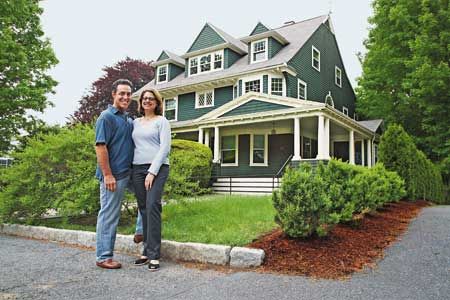
Paul Friedberg was a little startled when Tom Silva walked into his new house, a rambling suburban Shingle-style much in need of an update. It wasn’t so much that the familiar This Old House general contractor had come by to check out the place. Paul had invited him, after all, along with the show’s producers, to whom he was already giving the grand tour. It was more that Tom entered brandishing a video camera. “He just started filming me talking about our plans for the house,” says Paul. “Would I say it felt like an audition? Yeah, a little bit.”
Tom’s real intent was to document the house and get a record of the work to be done, but it was still a good sign. It meant Paul and his wife, Madeline Krauss, were in the running to be the next homeowners featured on This Old House TV. Just a couple of days earlier, they had e-mailed producer Deborah Hood their story, and now they had the whole production team in their Newton, Massachusetts, home. All told, it was just 72 hours from their e-mail pitch to getting the call that they’d been chosen to be on the show.
Seems quick, even for television. But finding a house for TOH TV to feature is the result of a unique mix of producer tenacity, homeowner pluck, and plain old good timing. Twice a year, the producers review thousands of proposals sent by eager homeowners, while simultaneously contacting architects, real estate agents, and historical boards for likely candidates. They also put a call out on our website.
So what are they looking for? Well, the good news is the answer changes with every project. But there are some constants. So if you’ve ever dreamed of getting the This Old House crew to show up at your doorstep, read on to find out what makes for a perfect project—and whether you might have what it takes.

Location, Location, Location
The show’s pros are real contractors who do other jobs in addition to what you see on TV, and they all live near Boston. So one of the yearly project houses is located within commuting distance for all of them. Tom Silva is the actual general contractor; he doesn’t just play one on TV. He’s on-site even when the klieg lights are off. (Have your doubts? Check out the 24-hour webcams.)
When the Boston-based project is finished, the crew hits the road, doing a winter project that’s usually covered in 8 to 10 episodes. To work in the off-season, they tend to head somewhere with a milder climate where construction goes full-tilt year-round—in the past they’ve hoofed it to Santa Barbara, Miami, Honolulu, and, most recently, Austin, Texas. But the show has overcome the cold in urban areas like Chicago and Washington and even London, England, too. Basically, if the story is compelling enough, the show travels to it.
A House with Some History
As a rule, TOH houses are old. But even 50 years old is enough to satisfy that requirement. And that’s not to say the producers wouldn’t consider a newer house,if it would make for great TV.
More important than age is diversity of style. If the show recently featured a Federal-style house, the crew would probably be looking for something quite different, maybe a Queen Anne or a Craftsman. “We’re really driven to change it up from what we did the year before,” says Hood. The architecturally ornate interior of the Newton house is a complete turnaround from last year’s projects, the modest two-family in East Boston and Austin’s green bungalow.
Lots of Stuff to Do
This Old House is not a one-day makeover show. It documents an entire renovation in up to 26 episodes, shaping a narrative out of weeks of ongoing construction. “We’re about quality and craftsmanship,” says Hood. “Those things take time—months, sometimes a year.”
The project has to run the gamut of what viewers at home might deal with in their own renovations, from plumbing to electrical to design. Work has to happen on exteriors, kitchens, bathrooms, bedrooms—pretty much everything. (Homeowners with much smaller projects can always try to get on Ask This Old House.) Though the Newton renovation will leave much of the house intact, it will include a total kitchen remodel and a master-suite expansion. And one of the biggest projects will be an extensive landscape redo.
A Plan, a Budget, and Time
Homeowners trying to get on the show (see “Our Favorite Appeals”) should know what they want. A vague notion that you need a new kitchen and would love a media room isn’t as compelling as a detailed description of your dream renovation, or better yet, architectural plans.
Plans don’t have to be final. Cambridge architect Treff LaFleche had a solid design for Paul and Maddy, but when TOH master carpenter Norm Abram walked the new kitchen layout, he pointed out how far they’d have to go from the stove to the porch door when they entertained outside. So another door was added nearer the work area (forever known as “the Norm door”).
Homeowners also have to be ready with the capital. As every TOH project owner knows, the show does not pay for the renovations. “You can’t just be like, ‘I’m so lucky!'” says Maddy. “You have to be financially ready to do a significant renovation.” That said, many companies are eager to work with the show and have been known to discount products or services, allowing homeowners to tackle a larger scope of work than they first considered. Just as key, it all has to be finished in the time frame—three months to a year—set by the show’s production schedule. What Paul and Maddy thought they’d do over seven years will now happen in just seven months.
No Fear of the Spotlight
There’s no way around it: If you want to work with This Old House, you’re going to be on camera. Often. Bottom line: The show is a documentary, recording a renovation through the experience of the crew and the homeowners. It’s not scripted, and nobody’s looking for actors. This is reality TV in the truest sense. The goal is to get everyone talking to each other as they do in real life.
“What we really liked when we first met everybody was how friendly they all were,” says Paul. “We’re so comfortable with them, and they’re all meticulous and patient.” That’s just the kind of rapport that makes a project a good fit for everyone involved.
Our Favorite Appeals
TOH TV’s producers reach out to pros across the country during their project searches, but it’s the homeowners, as much as their house, that help determine who makes the cut. Here’s a look at some of producer Deborah Hood’s favorite winning appeals.
East Boston, 2006
Hood was attracted to the modest project, but what really sold her was the exuberant personalities of owners Chris Flynn and Liz Bagley—and their sentimental pitch. “Purchasing the house with my aunt…just felt right—we are able to keep it in the family and celebrate more special times with our loved ones,” wrote Liz. “‘A person travels the world to see what he/she needs, then comes home to find it….’ I feel like this quote best describes my life—traveling and living in many parts of the globe, but always knowing that I would end up in East Boston,” wrote Chris, who also sent the appeal depicted in Slide 2 from Hawaii.
Austin, 2006
Michele Grieshaber’s e-mail to Hood about plans she and Michael Klug had for her Craftsman was less emotional, but all the right points were there. “It was a small house, a historic neighborhood, a family who was committed to doing a green renovation,” Hood says. “I was elated…I thought, This is IT!” One talk with Michele sealed the deal.
Cambridge, 2005
A Modern house wouldn’t have been the show’s first choice, but Hood felt George Mabry’s pitch was “incredibly well thought out.” As he wrote, “In the 12 years since I bought the house, it’s been tough figuring out what to do with it. Modern architecture was never my favorite, but I’ve come to accept that it’s the only thing that feels honest both to the existing house and the land.” And TOH agreed.
Tune in: The new season of This Old House premieres on PBS in October; go to the TV Schedule for your local listings.

